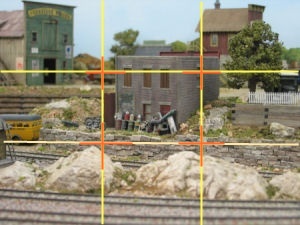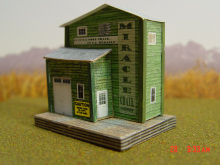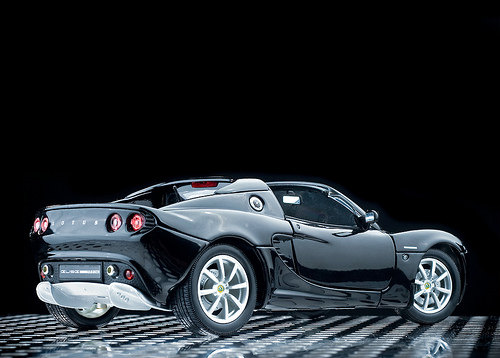
July 15, 2009
Share Your Best Efforts
Among 10 Billion Images
Good scale model photography today is not the luck involved in a single shot point-and-shoot quick snap, it does involve a convergence several factors including skill, lighting, composition and in some cases luck.
You can a first hand look at the good and bad in digital photography today by scanning your favorite topic among the 10 billion pictures residing in such online repositories as Flickr and Facebook, Photobucket, Pixagogo, or Fotoki.
Just type “scale modeling” into the search box for Flickr and you will pull up a list of 73,600 pictures ranging from a model of the city of Shanghai (well at least 25% of it) to an HO model of Debbie’s Diner.

The above image is not meant to be all inclusive of the logos for on-line storage facilities. This is a fast growing Internet business model using terabytes of storage.
The series of articles in this issue of Scale Modelers Handbook won’t make that a reality, but if you put a few of these methods into practice, you will catch the true scale modeler’s eye.
Composition Key In Catching Viewer's Eye
Composition is all about how you arrange the elements of the scene in front of you. When your subject is a scale model many of the basic axioms of good landscape photography carry over to modeling with a little augmentation.Scale is an important consideration. When possible take advantage of the unusual angles you can use as opposed to landscape shoots.
The helicopter view (overhead), eye level (shooting at desktop level) and a through-the-tunnel or bridge shot of a model train or armor vehicle can add new interest to your photography efforts.
Let’s look at several “rules” in composing your shots. By no means are these legally enforceable and they are not considered to be the only things you should consider when shooting pictures of your scale model, but they do offer a starting point.
 |
 |
| Capturing the foreground view of the Airbus adds interest to this photo. | It is hard to determine the area of interest, the plane, or the boy. |
 |
 |
 |
| Diagonal subject draws attention of viewer. | Horizontals like the rail cars dicide the scene. | Verticals impart durability. |
Lines Rule--The dominant line of the picture affects its mood. Vertical lines generally convey strength, massiveness, and durability; horizontal lines generally convey calm and repose; and diagonal lines are 'dynamic'. This is the most disputable of all the 'rules', but it still works most of the time.
 |
 |
| Capturing the foreground view of the Airbus adds interest to this photo. | It is hard to determine the area of interest, the plane, or the boy. |
Foreground Interest Rule--Having objects in the foreground can lend your landscapes a greater sense of depth. This works best with wide-angle lenses as these let you get closer to objects in the foreground and give it greater prominence in the final image.
 |
 |
| Framing the main content of your photo centers attention on the subject quickly. | This photo could have been more interesting centering subject between the chairs by lowering the camera. |
Framing Rule--It can be overdone, but if you don't do it, you may find that your picture just 'peters out' towards the edges.
By framing the scene, all the attention is concentrated on the main part of the picture. Rock formations, archways or trees with overhanging branches make great natural frames. It's best to be bold when using such frames for your landscapes. A few leaves or branches hanging at the top of the frame can look messy and unnatural, so try to include the whole tree to link the elements in the scene and join the trunk to the ground.
 |
 |
| By placing the subject in the lower third of the frame, this photographer captures the eye. | Even though seeminly suspended in mid air, a centered image, the plane seems lifeless. |
Rule of Thirds—This is likely the most well known principle of photographic composition and can be easily initiated to provide a well balanced and interesting shot. This, as well as the others here are not hard and fast rules of photography. But if you intend to break a rule, learn it first to be sure your breaking it will improve your photo.
 |
 |
 |
| S curve leads the eye |
Architectural objects start an S-shaped path |
Interest cools when viewed from the front. |
 |
 |
| You know this is not a full-sized Special Forces "dune buggy" because of the display plaque. |
This Duesenberg looks like you could open the door, climb behind the wheel and drive off. |
![]()
Scale Model Photography or
A Little Light On A Small Thing
Please don’t get me wrong, I am not or am not trying to be a “professional photographer”. I am trying to share with you some of the information I have learned over the past four decades that will help you produce better images of your modeling creations.This is important as (A) taking good photos and (B) being able to share them online helps others learn from your efforts and helps you see flaws in your own work you don’t see, or more likely don’t want to see because they stick in your craw.

One of the things I learned from my journalism days (too long ago to be discussed) is that good composition, even unusual composition, counts for a whole lot when photographing a scene and that carries over to photographing models. There are far too many point-and-shoot shots. Some of my most memorable shots as a newspaper reporter were taken from unusual angles. For instance, the editor’s eyes would always light up when he saw a photo of a parade shot from lying on the pavement as two lines of instrument players passed on either side.
You don’t have to go to that length in producing a pleasing shot of your model, but how about placing the camera directly on the table where you are close to eyeball height of a scale person whether in the scene or not. You will find these shots are more believable. The “focus” (I know, lousy pun) is on Digital cameras as they are extremely popular, make digital photo sharing possible and most importantly, because that is what I use. If you haven’t got one, this information is still valid but please realize you will be wasting a lot of time and effort you could be spending improving your modeling.
![]()
Watch Out For Your Back(ground)
It is real easy to get so totally engrossed in the subject of your photograph that you all but ignore what is behind it, Something in the background (even if it is out of focus) makes a big difference. In the real world you will seldom find a scene with nothing behind it and you surely won't find a scene with a bare wall or worse open stud work. Even if your scene is gazing off a cliff there is always something there; a tree line on a far hilltop, the rock wall of a canyon, of clouds in the sky.
In the real world you will seldom find a scene with nothing behind it and you surely won't find a scene with a bare wall or worse open stud work. Even if your scene is gazing off a cliff there is always something there; a tree line on a far hilltop, the rock wall of a canyon, of clouds in the sky. For instance, this tabletop shot of Miracle Chair would lose a lot if you removed the field of waving wheat and mountains in the background. (That would be pretty easy, just un-stick the tape holding the piece of stationary to the wall). It is amazing how simple (and inexpensive) tabletop photography can be. A Video Example of Tabletop Photography
What Makes The Shot?
Good photography requires good lighting and I have found I do my best model photography in an enclosed room with lighting I can control. Good photos are those with good exposure, no washed out area, and no harsh shadow. To achieve that, the light has to be soft.The bigger the light source, the softer the light. The more distance between the light source and the object, the softer the light. For most modelers, sunlight is a favorite lighting source as it is big, far away (soft light) and constant.
I tried the outdoor sunlight. Yes it is great light, but there are other weather elements that make it impractical. Just a slight breeze sends models and backgrounds flying, I can’t control the light’s intensity and I can’t move it closer or further away.
 |
| The above picture is a scale model of a Lotus Eliise perched on a stainless steel BBQ grill The number one ingredient in shooting quality pictures of scale models is lighting. A 2-megapixel digital can outshine a $7,500 Hasselblad H1 Single Lense Reflex if the lighting is pre-planned and well balanced. Okay, that’s enough of the professional stuff (I couldn’t even spell Hasselblad without Google). |
Let’s get on with our own reality. In most cases you will not need to delve too deeply into the professional side to get decent photos you can upload to your site, a photo storage site or a forum. Online reproduction of your photos can’t make use of top quality images without letting the air out of them. You can take great photos by taking them in extreme close up. Close up photos add a little creativity and drama to the photos as they provide a different viewpoint. This idea is only one of the many ways to enhance and create excitement in your photo. What Color Is White?
When taking pictures with a film camera it simply captures the light spectrums of a scene on a negative film. When it is developed, the processor will have to determine colors by guessing how the color should turn out. That’s why picture color changes from one processor to the next. Digital cameras accomplish this as the picture is being shot. The camera also guesses the right color by guessing the color of the light source. So, how do we solve this problem you ask? The answer is you tell the camera what the light source color is. Tell it how white color should look like, thus the term "white balance".
Good Setup Often Makes Photo Possible
Quick Tip: Detail Your Car Models
Plastic Car models, regardless of scale can be measurably improved for viewers by adding the details they remember about cars. look at hot rod magazines, on articles about show detailing, now do the opposite to your model, show cars hide wiring etc.Try show as much as you can, spark plug wires, battery leads, fuel lines, handbrake cables etc. Some models look good with a few extras, things like a scaled pizza box in the back seat, a stuffed animal, fluffy dice, even a flat tire etc.